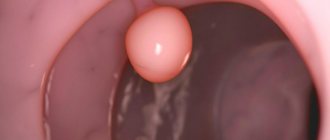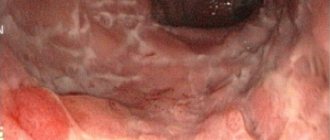What are polyps
Polyps are growths formed on the mucous membrane of an internal organ. It is benign and has an irregular or rounded shape. It often progresses, causing dangerous complications for the entire body.
Pathology can form on various organs, causing discomfort and pain.
Diagnosis, symptoms and treatment of tumors vary depending on their shape and location.
Types of polyps
There are several types of polyps:
- cholesterol. The most common diagnosis among all cases of detection of the disease. These formations are called false, and they can resolve on their own. When lipid metabolism is disturbed, cholesterol accumulates on the mucous membranes.
- Inflammatory. Another type of polyp occurs due to inflammation of the mucous membrane. This type of pathology grows against the background of an infection of the epithelium.
- Adenomatous. A neoplasm that arises due to the growth of glandular epithelial cells. Requires treatment and constant monitoring by specialists.
- Papillomas. It is characterized by multiple growths and there is a risk of developing into cancer.
What are the types of gallbladder polyps?
Depending on their origin, polyps are divided into pseudopolyps and real (true) polyps.
True polyps grow directly from the cells of the mucous membrane, they are divided into:
- adenomatous;
- papillomatous;
- papillary growths of the gallbladder.
Pseudopolyps, in turn, are divided into the following types:
- Cholesterol polyps. They are a formation of modified mucous membrane with cholesterol deposits. This is the most common type of this pathology, accounting for about 57–80% of all polyps.
- Inflammatory polyps. They occur in up to 10% of all polyps and are granulation tissue growths in response to inflammation. As a rule, they are formed as a result of cholecystitis, cholelithiasis and other inflammatory processes that lead to focal proliferation of the gallbladder mucosa.
- Calcified polyps are fixed stones consisting of layered metabolites of the gallbladder. Occurs in less than 1% of cases.
Since there is no single point of view on the cause of the polypoid form of gallbladder cancer, it is widely believed that all polypoid formations, except cholesterol ones, pose a threat of malignancy - and therefore must be treated surgically.
Causes
There are factors that contribute to the occurrence of the disease:
- Heredity. A high risk of developing the disease occurs in people whose relatives have suffered from this disease.
- Chronic cholecystitis. Stagnation of bile leads to an increase in the tissue of the internal organ.
- High-calorie food. High cholesterol content in food provokes the development of the disease.
- The hormone estrogen. An increase in the production of this hormone entails the growth of the epithelium in the gallbladder (abbreviated gallbladder). Because of this, women suffer from this disease more often than men.
- Inflammatory process. During inflammation, the body turns on protective processes in tissues and organs, and this contributes to the onset of pathology.
- Impaired metabolism. Improper nutrition or heredity leads to disruption of the outflow of bile, as a result of which the tissue of the internal organ begins to grow.
- Dyskinesia. Improper functioning of the biliary tract directly affects the development of pathology.
- Hepatitis and papilloma virus. Both of these diseases can cause tumors.
Infections and stress, physical inactivity affect the functioning of internal organs and digestion. A congenital anomaly in the structure of the gallbladder can affect the digestion process and cause pathology.
Who may develop neoplasms
Today, there are several risk factors that can contribute to the appearance of these tumors. First of all, hereditary factors are considered. If relatives have a history of formations of the gallbladder or other organs (such as Gardner or Petz-Jeghers syndrome), the risk of polyps increases.
The formation of pseudopolyps can be facilitated by hereditary pathologies associated with disruption of the biliary system, such as: biliary dyskinesia; Gilbert's syndrome; increased content of cholesterol and bile salts in bile.
Oversaturation of bile with cholesterol and bile salts in the presence of disturbances in the motor activity of the gallbladder creates the preconditions for the precipitation of dense components of bile and the formation of first clots and then pseudopolyps.
Other causes of polyps in the gallbladder can be infectious diseases. Microorganisms penetrate the gallbladder tissue and contribute to an increase in cell size with the subsequent development of polyps, which regress when the inflammatory process subsides.
Risk factors also include nutritional reasons, that is, nutritional problems. Overeating or poor nutrition can contribute to irritation of the digestive system. An important factor is the level of cholesterol in the body. An increase in its concentration can lead to biliary sludge: an accumulation of cholesterol crystals that form a cholesterol polyp in the gallbladder.
Symptoms
Signs indicating existing growths in the body may differ from each other. It depends on their location. A gallbladder polyp blocking the duct, the symptoms of which cause jaundice, is dangerous to health.
The presence of a tumor in another location of the gallbladder (GB) does not give clear signs, and the presence of small formations may be asymptomatic.
Yellowing of the skin and sclera indicates a possible increase in bilirubin. This happens when bile enters the blood.
The release of bile into the stomach due to hyperactivity of the gallbladder is detected in the form of bitterness in the mouth. Due to the stretching of the walls of the patient's gallbladder, painful sensations occur. Discomfort occurs after eating heavy meals and overeating.
General clinical symptoms of the disease:
- jaundice;
- nausea and vomiting attacks;
- colic in the liver;
- painful sensations;
- flatulence and constipation;
- feeling of bitterness in the mouth;
- acid belching.
Diagnosis of polyps
To cure polyps in the gallbladder, the attending physician must prescribe a comprehensive diagnosis. At the initial appointment, the specialist collects a family history, determines the clinical picture of the disease, and the time of onset of symptoms. Next, a visual examination of the patient and palpation of the abdominal area are performed.
The following instrumental diagnostic methods are widely used to identify polyps:
- Ultrasound. During the procedure, single and multiple neoplasms can be detected. They are visualized as round tumors that are associated with the gallbladder mucosa and do not have acoustic shadows;
- Ultrasonography. The method involves a person swallowing a flexible endoscope, which helps visualize the walls of the duodenum and gallbladder. The study allows the specialist to obtain high-quality images of organs, which increases the diagnostic efficiency;
- CT and magnetic resonance cholangiography. Diagnostic measures help determine the localization of tumors, the nature of polyps, and the presence of concomitant pathologies that arise against the background of tumor malignancy.
Diagnostics and therapy
To make a correct diagnosis of a patient, a specialist doctor needs to conduct ultrasound diagnostics.
The ultrasound diagnostic method is an informative way to identify pathological changes in the body. An external examination of the body is performed using an ultrasound sensor. It makes it possible to identify the presence of formations, their shape and size, and indicates whether it is necessary to resort to the help of surgeons, or whether conservative treatment can be done.
Preparing for the examination does not require any special conditions, but you should avoid eating heavy food on the day of the ultrasound.
Endoscopic ultrasonography
This method involves inserting an ultrasound probe into the intestinal cavity using an endoscope. The high-frequency sensor examines tissue with a diameter of 12 cm, which allows you to obtain a qualitative assessment of the condition.
Small probes are inserted through the mouth into the stomach, and then into the intestinal cavity. The examination is carried out on an empty stomach; the day before the examination you should not eat heavy food.
CT scan
The tomography method helps to identify the location, structure, and cause of its appearance. With its help, even very small formations are visible. The procedure itself is harmless, but has a fairly high cost. Does not require special preparation.
Laboratory diagnostics include:
- blood chemistry;
- Analysis of urine;
- stool analysis.
If a pathology is detected in a patient, conservative therapy is often prescribed. Nutrition adjustments, special diets and medications are prescribed. Often, after conservative therapy, cholesterol formations resolve.
Other types of small growths are regularly observed, and follow-up examinations are prescribed. A tumor that does not increase in size is not touched.
Prohibited foods: meat, fatty fish, smoked and canned foods, spices, baked goods, full-fat milk.
Allowed in small quantities: onions, herbs, butter, fresh vegetables.
Allowed to consume: lean meat products (boiled), eggs, peeled fruits, non-concentrated juices, low-fat cottage cheese, stewed and steamed foods.
Diagnostics
The general diagnostic program may include the following:
- general urine analysis;
- microscopy of feces;
- blood chemistry;
- endoscopic ultrasonography;
- Ultrasound of the abdominal organs;
- CT or MRI.
Depending on the current clinical picture and to differentiate certain diseases, the doctor may prescribe additional laboratory or instrumental examination methods. Also, based on the examination results, the doctor decides whether the polyps need to be removed surgically, or whether drug therapy will be sufficient. However, it should be noted that in most cases the treatment is radical.
Complications
The likelihood of complications depends on timely diagnosis and proper treatment.
Polyps in the gallbladder during pregnancy in women pose a threat to the health and life of the child. The accumulation of bilirubin in the blood leads to intoxication of the fetus and affects its nervous system and brain cells, and there is a high risk of giving birth to a child with jaundice.
Let's consider possible complications.
Transformation into oncology
The likelihood of becoming malignant depends on the size of the tumor. Up to 35% of all cases of pathology, and in half of people with a growth of more than 20 mm, cancer develops.
The problem with timely diagnosis is the absence of symptoms in a person.
Inflammation of the gallbladder
The presence of polyps in the gallbladder provokes its inflammation, which increases with tumor growth. This leads to severe pain, constipation, and flatulence, which increases after eating heavy food.
Bile flow problems
Large growths interfere with the passage of bile, this causes its stagnation and is accompanied by bitterness in the mouth, loss of appetite, sharp pain and weakness.
Cholestasis is accompanied by yellowing of the skin color, itching, and stool becomes light-colored and mushy.
Cholecystitis
Inflammation in the cavity of the gallbladder leads to the development of purulent cholecystitis. It brings the patient to a serious condition, characterized by severe and regular pain.
What is dangerous about the affected gallbladder:
- Gangrenous cholecystitis is a complication of purulent cholecystitis.
- Peritonitis is inflammation in the peritoneum due to pus.
- Liver abscess - occurs when purulent contents enter the liver.
- Cholangitis – bile ducts become inflamed, leading to blood poisoning.
Consequences also include:
- osteoporosis;
- liver and kidney failure;
- cirrhosis of the liver.
Treatment of the disease
Drug treatment of polyps is ineffective. Drugs are used only to eliminate or prevent background ailments. The doctor may include the following medications in the treatment program:
- to stimulate bile secretion and improve peristalsis of the gallbladder (“holiver”);
- antispasmodics or painkillers;
- to reduce cholesterol levels;
- substances to destroy cholesterol deposits.
In addition, it is imperative to follow a diet both before and after surgery. The diet plan is determined by the doctor, but the following is definitely excluded from the diet:
- fatty, spicy and too salty;
- sweets - especially confectionery products with creams that contain large amounts of fat and artificial colors;
- smoked meats, pickled products;
- citrus;
- legumes;
- alcohol.
Preference should be given to foods that are prepared with minimal or no fat, boiled, steamed or baked. The consistency should be liquid or puree.
Surgical treatment is the most effective treatment for this disease. Indications for surgical removal of tumors are:
- the size of the neoplasm is more than 1 centimeter;
- there are cases of cancer in the family history;
- if the polyp has formed against the background of another pathological process;
- if the tumor grows;
- if multiple polyps are diagnosed in an organ, especially in the biliary tract;
- in the event that gallstones are additionally identified.
“Treatment” without surgery can lead to the development of the following complications:
- inflammation of the walls of the gallbladder, which entails other pathologies;
- purulent cholecystitis;
- deterioration of bile outflow with all the ensuing consequences;
- malignant transformation of polyps.
However, if the operation is performed in a timely manner, the complications described above can be avoided.
Treatment
If a person is diagnosed with polyps in the gallbladder, treatment depends on their type and size. Conservative types of treatment are the elimination not of the neoplasms themselves, but of the causes of the pathology. Treatment without surgery helps in the initial stages of the disease.
Depending on the nature of the disease, the doctor prescribes appropriate therapy. It is strictly forbidden to self-medicate; at the first sign you should go to the doctor.
Non-surgical recovery methods include:
- drugs that dilute bile - Ursosan, Ursofalk. They contain acid that dissolves stones and prevents the formation of new ones;
- "Motilium" - strengthens the walls of the gallbladder and improves digestion;
- “Gepabene”, “No-shpa” - to relieve the symptoms of the disease;
- treatment with folk remedies. Infusions and herbs help strengthen the body and improve the functioning of internal organs. Infusions of celandine or chamomile, rose hips and other fruits are taken for at least a month.
Additional medications may be prescribed, depending on the patient's complaints about certain symptoms.
Operation
In some cases, having diagnosed a gallbladder polyp, surgery is not only necessary, but can also save the patient’s life.
Surgical intervention is performed in the following cases:
- polyp enlarges by more than 1 cm;
- rapid tumor growth;
- a large number of formations, with a tendency to increase;
- for cholelithiasis (GSD);
- for chronic inflammation of the gallbladder.
Removal of a polyp in the gallbladder is indicated when it becomes cancerous, purulent cholecystitis, high levels of bilirubin and severe colic.
Let's consider the types of surgical operations.
Laparoscopic
The operation is performed using endoscopes. Hollow tubes with valves are inserted into the punctures in the abdominal wall. A special camera and laparoscope are passed through them.
The advantages are minimal pain after surgery, low likelihood of developing adhesions and infections.
Open surgery
During the operation, the gallbladder is removed through incisions in the abdominal wall (laparotomy). It is performed using an oblique incision, providing access to the gallbladder and liver.
Laparotomy is used when the size of the growth increases to 18 mm, which has a high risk of developing into a cancerous form.
After surgery, the patient continues to feel pain for some time and is observed in the hospital. The patient is prescribed a strict diet and bed rest.
How do polyps in the gallbladder manifest themselves?
Symptoms of gallbladder polyps may vary depending on the type of polyp, its size and location.
In the early stages of development, the pathology usually does not manifest itself in any way. As the polyp develops, symptoms such as nausea, a bitter taste in the mouth, and discomfort in the right hypochondrium, which intensifies after eating, may occur.
The occurrence of inflammation in the gallbladder (cholecystitis) can increase symptoms:
- Dyspeptic disorders include sour-tasting belching, heartburn, nausea and a bitter taste in the mouth.
- Vomiting is repeated, often occurs after eating, and does not bring relief. Often attacks of vomiting reach the point that only gastric juice and bile remain in the vomit.
- The pain intensifies after eating and subsides after a few hours. The nature of the pain can be stabbing, cutting, cramping or aching.
If the polyp reaches a large size and blocks the outflow of bile, obstructive jaundice occurs, which is easily identified by the yellow color of the skin and sclera of the eyes. However, this is a very rare situation.
Pain can be a symptom of other gallbladder diseases. Read the article about what the nature of the pain can tell about its root cause and how to treat pain in the gallbladder.
Prevention
To avoid the development of pathology, it is necessary to eliminate factors that contribute to the formation of the disease.
Prevention measures include:
- Regular medical examination is an important factor, especially in the presence of a family history. The study includes ultrasound, a diagnostic that effectively detects up to 95% of lesions.
- Normalization of lipid metabolism is necessary to prevent the accumulation of cholesterol, which leads to the appearance of polyps. Poor nutrition, physical inactivity, and digestive diseases are factors that aggravate the pathology.
- Timely treatment of inflammation of the gallbladder is an important factor in preventing changes in the structure of the organ and the formation of tumors. A timely cured disease saves you from a number of complications.
Prevention of bile stagnation. To do this, you need to adhere to the rules of food intake, diet, and sports lifestyle. It is necessary to include fiber in your diet and limit animal fats.
The main methods of preventing complications are maintaining a healthy lifestyle, proper nutrition and regular visits to the doctor.
Preventive measures
In order to avoid the appearance of cholesterol polyps in the gallbladder, it is necessary to take preventive measures that will help you get rid of repeated treatment of this problem.
Prevention of the occurrence of the disease can be carried out in the following:
- To undergo a preventive ultrasound examination of the abdominal cavity in a timely manner (once or twice a year);
- Normalize fat metabolism through proper nutrition and moderate physical activity;
- Avoid the occurrence of diseases such as: gastrin, pancreatitis, gastrointestinal tract, ulcers, infectious diseases, etc. If such diseases arise, treat them promptly and do not neglect them;
- Lead an active lifestyle. Frequently walk in the fresh air, exercise moderately (without fanaticism), do morning exercises, dance or bike rides, etc.
A healthy, active lifestyle is extremely important, since physical inactivity contributes to metabolic disorders and a decrease in the body’s protective functions. In turn, this can lead to the recurrence of cholesterol polyps.
Diet
A sick patient needs to follow a special diet so as not to aggravate the pathology and avoid complications. The goal of the diet is to relieve the digestive organs from excessive stress.
Strict nutritional controls include:
- dividing the daily meal into 5-6 times a day;
- food should be in liquid or pureed form;
- ban on sweet foods, bread, seasonings and canned food;
- complete exclusion of coffee, soda and alcohol;
- drinking large amounts of water;
- vegetable soup - puree in the diet;
- eat vegetables only boiled or baked;
- It is forbidden to eat hot or cold food.
The strict diet must be followed for six months or more, at the discretion of the doctor. It is important to give up bad habits and maintain the correct daily routine.
Classification
Most often, polyps are located on the mucous membrane of the walls of the gallbladder, attached to a wide base or stalk, and grow into the bladder.
Since the symptoms of their appearance are similar to other gastrointestinal diseases, diagnosing the pathology is very problematic.
There are the following types of formations:
- Adenomatous. In this case, the polyps are benign. Their growth is provoked by the proliferation of glandular tissues. Polyps tend to transform into malignant formations. Therefore, it is so important to consult a doctor as early as possible, who can exercise constant control over them.
- Papillomas. They are a benign formation. But due to their papillary shape, they can transform into a malignant tumor.
- Polyps of an inflammatory nature, the appearance of which is provoked by various factors that irritate the mucous membrane of the organ. Even parasites can be the cause. This form is not tumorous, since polyps are provoked by inflammatory phenomena.
- Cholesterol polyps. These formations appear against the background of an excess amount of cholesterol in the blood, with a violation of fat metabolism in the body. The most common today are cholesterol polyps, which are treated with conservative methods of therapy.
Is there a connection with other diseases?
Gallbladder polyps are often discovered when the patient complains of unpleasant symptoms. The patient must be carefully examined and a full diagnosis carried out. Only an abdominal ultrasound can reveal the presence of tumors.
Often, in parallel with this disease, other, no less serious, diseases are detected.
Most often this is:
- Pancreatitis. This is an inflammation of the pancreas, which manifests itself as pain in the right hypochondrium. Nausea, vomiting, and stool disturbances occur.
- Chronic cholecystitis. Most often, this disease occurs due to a bacterial inflammatory process. But even parasites can cause it.
- Cholelithiasis. With this disease, stones form in the gallbladder cavity or ducts due to lipid metabolism disorders.












